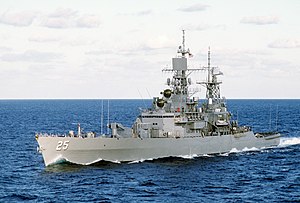United States Navy 1975 ship reclassification

The United States Navy reclassified many of its surface vessels in 1975, changing terminology and hull classification symbols for cruisers, frigates, and ocean escorts.
Classification prior to 1975
From the 1950s to 1975, the US Navy had three types of fast task force escorts and one type of convoy escort. The task force escorts were cruisers (hull classification symbols CAG/CLG/CG), frigates or destroyer-leaders (DL/DLG), and destroyers (DD/DDG); the convoy escorts were ocean escorts (DE/DEG), often called destroyer escorts as they retained the designation and number series of the World War II vessels. Added in the early 1970s was a new ocean escort called the patrol frigate (PF), another designation previously used in World War II, which was the initial designation of the Oliver Hazard Perry class.[1] In 1975, these classifications were simplified to cruiser (CG), destroyer (DD/DDG), and frigate (FF/FFG).
Under the pre-1975 classification, cruisers were large vessels, the size of
From 1950 to 1975, frigates were a new type, midway between cruiser and destroyer sizes, intended as major task force escorts. The first ship of the type was a redesignated
Destroyers were developed from the World War II designs as the smallest fast task force escorts. DDs were fast ASW ships; DDGs were AAW ships carrying the short-range
Ocean escorts were an evolution of the World War II destroyer escort types. They were intended as convoy escorts and were designed for mobilization production in wartime or low-cost mass production in peacetime. DEs were ASW vessels; DEGs were AAW vessels with Tartar missiles.
The U.S. frigate classification was not used by any other navy; similar vessels were either cruisers or destroyers in foreign service.[3] The ocean escort type corresponded to foreign frigates (convoy escorts).
The "cruiser gap"
The
The differing U.S. and Soviet definitions of "cruiser" caused political problems when comparisons were made between U.S. and Soviet naval forces. A table comparing U.S. and Soviet cruiser forces showed six U.S. ships vs. 19 Soviet ships, despite the existence of 21 U.S. "frigates" equal or superior in size to the Soviet "cruisers". This led to the perception of a non-existent "cruiser gap".
Closing the gap
To close this "gap," the U.S. frigate (DL/DLG) classification was eliminated on 30 June 1975. All the gun frigates (DL) had already been stricken or converted to DDGs. Most of the DLGs became cruisers (CG), but the smaller
The ocean escorts (DE/DEG) and patrol frigates (PF) became frigates (FF) or guided missile frigates (FFG).[1]
These changes brought U.S. Navy classifications into line with foreign classifications, and eliminated the perceived "cruiser gap."
| Pre-30 June 1975 | Post-30 June 1975 |
| Cruiser (CA/CLG/CGN) | Guided Missile Cruiser (CG/CGN) |
| Frigate (DL/DLG/DLGN) | Guided Missile Cruiser (CG/CGN), Destroyer (DD), or Guided Missile Destroyer (DDG) |
| Destroyer (DD/DDG) | Destroyer (DD) or Guided Missile Destroyer (DDG) |
| Ocean Escort (DE/DEG) | Frigate (FF) or Guided Missile Frigate (FFG) |
| Patrol Frigate (PF) | Guided Missile Frigate (FFG) |
A final change came on 1 January 1980, when the Ticonderoga class guided missile destroyers (DDG) became guided missile cruisers (CG).
References
Sources
- sci.military.naval, "F.8", Part F Surface Combatants FAQ, Hazegray.
- ISBN 0-313-26202-0.
- ISBN 0-87021-718-6.
